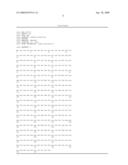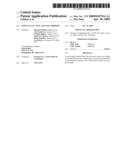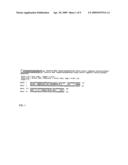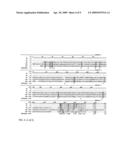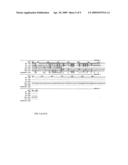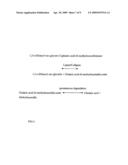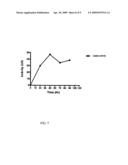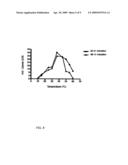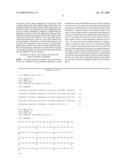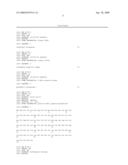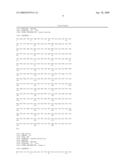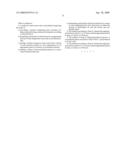Patent application title: Novel plant gene and uses thereof
Inventors:
Manuel Gidekel (Temuco, CL)
Ana Gutierrez (Temuco, CL)
Claudia Rabert (Temuco, CL)
Gustavo Cabrera (Temuco, CL)
Jaime Sanchez (Temuco, CL)
Leon Bravo (Comuna De Coronel, CL)
Assignees:
Vitrogen S.A
UNIVERSIDAD DE CONCEPCION
IPC8 Class: AC02F168FI
USPC Class:
210632
Class name: Liquid purification or separation processes treating by enzyme
Publication date: 2009-04-30
Patent application number: 20090107914
Claims:
1. A method to clean waste water, said method comprising the steps of:a)
providing a mixture comprising active amounts of a lipase enzyme having
an amino acid sequence according to SEQ ID NO:2;b) immersing said mixture
in fresh water for an appropriate period at water temperature to provide
an activated mixture;c) mixing a volume of aqueous water waste with a
volume of said activated mixture at room temperature for an appropriate
period to produce an acclimated mixture;d) adding a volume of said
acclimated mixture to a wastewater treatment tank and;e) maintaining said
mixture and said wastewater in contact at water temperature for one to
three days to reduce the amount of undesirable oil, fats and wastes and
suspended solids.
2. The method according to claim 1, wherein the appropriate period in step b) is 1 to 3 hours and the appropriate period in step c) is from 2 to 48 hours.
3. The method of claim 1, wherein the lipase enzyme is a recombinant lipase encoded by SEQ ID NO: 1 and produced in Pichia cells.
4. The method according to claim 3, wherein the appropriate period in step b) is 1 to 3 hours and the appropriate period in step c) is from 2 to 48 hours.
Description:
PRIORITY DATA
[0001]This application is a divisional application of U.S. non provisional application Ser. No. 11/787,383 filed on Apr. 16, 2007.
SEQUENCE DATA
[0002]This application contains sequence data provided on a computer readable diskette and as a paper version. The paper version of the sequence data is identical to the data provided on the diskette.
BACKGROUND OF THE INVENTION
[0003]1. Field of the Invention
[0004]The present invention relates generally to the field of plant molecular biology. More specifically the invention relates to nucleic acid fragment encoding plant lipase and uses thereof.
[0005]2. Description of Related Art
[0006]Lipases (triacylglycerol acylhydrolase, EC 3.1.1.3) belong to the family of hydrolases that act on carboxylic ester bonds. In addition to their natural function of hydrolyzing carboxylic ester bonds, lipases can catalyze esterification, interesterification, and transesterification reactions in non aqueous media. Due to this versatility lipases have a variety of potential applications for industrial uses. Examples of fields where lipases have applications are such as dairy industry, detergents, oleo chemical industry, pharmaceutical and cosmetic industry, medical and environmental applications. Depending on the process, the required characteristics of the lipase enzymes are different. For purposes where for example processing temperatures are high, one would need to have enzyme with high optimal temperature, for another process one may need to have an enzyme having low pH tolerance etc. Moreover, the modern biotechnology has enabled production of industrial enzymes such as lipases cell cultures, whereby the production costs can be dramatically lowered.
[0007]GDSL lipases are an important family of lipases. GDSL lipases are widely found in microbes, and a number of bacterial GDSL genes have been cloned and characterized. GDSL lipases are also found in plant species, and several candidates from various plant species such as Arabidopsis thaliana, Rauvolfia serpentina, Medigago sativa, Hevea brasiliensis, Brassica napus, Oryza sativa and Alopecurus myosuroides have been isolated, cloned and characterized.
[0008]Due to the large variety of industrial uses where lipase enzymes can be used, there is a clear need to identify and characterize new enzymes and genes coding for them and provide systems for industrial production of the enzymes.
[0009]Accordingly, identification and characterization of genes coding for lipase like proteins in plant species tolerant to low temperatures can provide novel enzymes for industrial applications. A plant species extremely tolerant to low temperatures is Deschampsia antarctica Desv. (Poacea). Accordingly, we have studied the gene expression of this vascular plant naturally colonizing Maritime Antarctic Peninsula.
SUMMARY OF THE INVENTION
[0010]Due to the increased interest in lipases in various fields of industry, there is a clear need for novel lipase enzymes. Especially, there is a need for novel lipase enzymes functional in wide range of temperatures. Moreover, there is a need for a method for economic production of lipase enzymes.
[0011]Accordingly, an object of the current invention is to provide a novel recombinant lipase, which is psycrophilic and can therefore stand low temperatures.
[0012]Another object of the current invention is to provide a simple and rapid method of producing lipase enzyme in host cell and subsequent purification of recombinant lipase.
[0013]An even further object of the current invention is to provide a novel lipase that can be used in waste water cleaning.
[0014]A further object of the current invention is to provide a novel lipase to be used as a component in sun screens.
[0015]According to a preferred embodiment the lipase enzyme is encoded by a nucleotide sequence essentially according to SEQ ID NO: 1 isolated from Deschampsia antarctica.
[0016]In a preferred embodiment, lipase enzyme of the present invention comprises the amino acid sequence essentially according to SEQ ID NO: 2.
[0017]Yet another embodiment of the present invention is a chimeric gene comprising an isolated nucleotide sequence encoding lipase like protein of Deschampsia antarctica.
[0018]An even further embodiment of the present invention is isolated host cells comprising the chimeric gene. The host cell may be eukaryotic, such as yeast or a plant cell, or it may be prokaryotic such as a bacterial cell. According to one embodiment the host cell comprising the chimeric gene is a Pichia cell.
[0019]An even further embodiment of the instant invention is to provide a process for cultivating host cells comprising the chimeric gene and isolating the recombinant enzyme produced in the cells.
[0020]Yet another embodiment of the instant invention is to provide a lipase enzyme for purposes of waste water cleaning.
[0021]An even further embodiment of the instant invention is to provide a sunscreen comprising the plant lipase of this invention.
BRIEF DESCRIPTION OF THE DRAWINGS
[0022]FIG. 1. shows the BLAST analysis of lipase clone 3F9 (SEQ ID NO: 2) with a putative GDSL lipase/acylhydrolase of Oryza sativa (japonica cultivar-group) (SEQ ID NO:6).
[0023]FIG. 2. illustrates a comparison of Deschampsia antarctica (Da) (SEQ ID NO:1) and Oryza sativa (Os) lipase protein-encoding gene (SEQ ID NO:6) showing the consensus region.
[0024]FIG. 3. depicts a phylogenetic tree displaying the inherited relationships between lipase 3F9 of Deschampsia antarctica (Da), putative GDSL lipase/acylhydrolase of Oryza sativa (Os), lipase homolog of Arabidopsis thaliana (At), lipase A (CaA) and lipase precursor B (CaB) of Candida antarctica.
[0025]FIG. 4 shows an alignment of Deschampsia antartica lipase (SEQ ID NO: 2) with previously cloned lipases using the Vector NTI 7 software. Deschampsia antarctica lipase 3F9 (Da) (SEQ ID NO:2), putative GDSL lipase/acylhydrolase of Oryza sativa (Os) (SEQ ID NO:6), lipase homolog of Arabidopsis thaliana (At) (SEQ ID NO:7), lipase A (CaA) (SEQ ID NO:8) and lipase precursor B (CaB) of Candida antarctica (SEQ ID NO:9) and consensus region.
[0026]FIG. 5 depicts the expression vector pPICZalphaB-Lipase 3F9 Clon1 of Deschampsia Antarctica, the ORF with the alpha factor (secretor signal) and the 6×His tag to facilitate the protein purification.
[0027]FIG. 6 shows the reaction sequence employed in the commercial kit to measure lipase activity in P. pastori cell culture.
[0028]FIG. 7 illustrates the determination of lipase activity (U/L) at different induction times with methanol in P. pastoris broth.
[0029]FIG. 8 illustrates lipase activity (U/L) at different temperature at 48 hours and 96 hours induction period.
DETAILED DESCRIPTION OF THE INVENTION
[0030]A cDNA expression library was obtained by using DNA samples of Deschampsia antarctica. This library enabled identification of one gene which encoded a lipase-like enzyme (triglyceride lipases EC 3.1.1.3). The cDNA gene sequence encoding the lipase of Deschampsia antarctica is according to SEQ ID NO: 1.
[0031]This full length gene sequence was further compared with other gene sequences available in a public GeneBank (BLAST). The clone 3F9 showed homology (69% positive) with a putative GDSL lipase/acylhydrolase of Oryza sativa (japonica cultivar-group) having the sequence identified as AAT93907.1. The comparison is shown in FIG. 1.
[0032]The alignment of lipase 3F9 clone with the putative GDSL lipase/acylhydrolase of Oryza sativa (japonica cultivar-group) gene was conducted by using the Vector NTI 7 software. The amino acid sequence for both lipases showed a 52.5% identity and 63.4% similarity (FIG. 2). This clearly indicates that the plant lipase gene of this disclosure is novel.
[0033]A phylogenetic analysis of several plant and bacterial lipases was carried out in order to illustrate the presumed evolutionary relationships among them and to infer their evolutionary history. For this purpose, the lipase 3F9 of Deschampsia antarctica (Da), putative GDSL lipase/acylhydrolase of Oryza sativa (Os), lipase homolog of Arabidopsis thaliana (At), lipase A (CaA) and lipase precursor B (CaB) of Candida antarctica (FIG. 4) were compared. Finally, a phylogenetic tree was built (FIG. 3). It was found that there was no phylogenetic relationship between Deschampsia antarctica lipase 3F9 and lipase homolog of Arabidopsis thaliana, lipase B precursor and lipase A of Candida antarctica. The only phylogenetically related protein is the Oryza sativa lipase, which was previously demonstrated having only a 63.4% of similarity.
[0034]In order to assure that Deschampsia antarctica 3F9 protein is novel a further comparison with functional related lipases was conducted by using a GenBank information. The simultaneous alignment of D. antractica lipase 3F9, putative GDSL lipase/acylhydrolase of Oryza sativa, lipase homolog of Arabidopsis thaliana, lipase B precursor and lipase A of Candida antarctica are shown in FIG. 4. The amino acid sequence of lipase 3F9 of Deschampsia antarctica showed 52.5% identity with lipase protein of Oryza sativa, 8.3% identity with lipase protein of Arabidopsis thaliana, only 2.4% identity with Candida antarctica chain A and 4.1% identity with Candida antarctica chain B.
[0035]The molecular weight of 3F9 lipase of D. antarctica is 10.3 kDa, while the molecular weight of lipase of O. sativa is 11.1 kDa, and that of A. thaliana is 33.3 kDa. The isoelectric point of 3F9 lipase of D. antarctica is 8.99, while that of lipase of O. sativa is 9.26 and the isoelectric point of lipase of A. thaliana is 9.20. Thus, clearly also the biochemical characterization of the instant plant lipase is distinct from the known proteins with similar function. The results from the sequence comparison and the biochemical analysis are summarized in Tables 1 and 2.
TABLE-US-00001 TABLE 1 Identity comparison of the amino acid sequence of lipase 3F9 of D. antarctica with other lipases. Deschampsia antarctica (Da) Similarity (%) Identity (%) Oryza sativa (Os) 63.4 52.5 Arabidopsis thaliana (At) 11 8.3 Candida antarctica chain A (CaA) 5.4 2.4 Candida antarctica chain B (CaB) 8.2 4.1
TABLE-US-00002 TABLE 2 Biochemical comparison of lipase properties isolated from different sources. Molecular Weight Isoelectric KDa point Deschampsia antarctica (Da) 10.3 8.99 Orysa sativa (Os) 11.1 9.26 Arabidopsis thaliana (At) 33.3 9.20 Candida antarctica chain A (CaA) 49.2 5.33 Candida antarctica chain B (CaB) 33 5.80
[0036]The amino acid sequence of Deschampsia antarctica lipase deduced from DNA sequence is according to SEQ ID NO: 2. The amino acid composition of the lipase protein encoded by DNA sequence is presented in Table 3.
TABLE-US-00003 TABLE 3 Amino acid composition of Deschampsia antarctica lipase deduced from DNA sequence. Number % by % by Amino Acid(s) count weight frequency Charged (RKHYCDE) 27 33.36 27.84 Acidic (DE) 6 6.95 6.19 Basic (KR) 10 12.55 10.31 Polar (NCQSTY) 24 25.26 24.74 Hydrophobic (AILFWV) 30 32.66 30.93 A Ala 6 4.42 6.19 C Cys 4 4.01 4.12 D Asp 3 3.30 3.09 E Glu 3 3.65 3.09 F Phe 6 8.20 6.19 G Gly 15 9.31 15.46 H His 3 3.85 3.09 I Ile 3 3.25 3.09 K Lys 8 9.67 8.25 L Leu 7 7.59 7.22 M Met 3 3.70 3.09 N Asn 5 5.46 5.15 P Pro 6 5.71 6.19 Q Gln 0 0.00 0.00 R Arg 2 2.88 2.06 S Ser 9 7.82 9.28 T Thr 2 1.97 2.06 V Val 6 5.81 6.19 W Trp 2 3.38 2.06 Y Tyr 4 5.99 4.12 B Asx 8 8.77 8.25 Z Glx 3 3.65 3.09 X Xxx 0 0.00 0.00
[0037]The present invention is now further defined in the following examples. It should be understood that these examples, while indicating preferred embodiments of the invention, are given by way of illustration only. It would be apparent to one skilled in the art that various modifications of the invention in addition to those shown and described herein are within the scope of the invention.
EXAMPLE 1 STRAINS, VECTORS AND CULTURE MEDIA
[0038]Escherichia coli strain DH5α (Invitrogen) was selected for vector construction and Pichia pastoris strain X-33 (Invitrogen) was used to express the Deschampsia antarctica lipase 3F9. E. coli was grown in low salt LB-Zeocin medium (1% tryptone, 0.5% yeast extract, 0.5% NaCl and 25 μg/ml of zeocin).
[0039]Pichia pastoris was grown in YPD medium (1% yeast extract, 2% peptone, 2% dextrose) for general growth and storage and in BMGY medium (1% yeast extract, 2% peptone, 100 mM potassium phosphate, pH 6.0, 1.34% YNB, 4×10-5% biotin, 1% glycerol) or in BMMY medium (1% yeast extract, 2% peptone, 100 mM potassium phosphate, pH 6.0, 1.34% YNB, 4×10-5% biotin, 0.5% methanol) to generate biomass or to induce expression, respectively. Zeocin 100 μg/ml agar plates were used (1% yeast extract, 2% peptone, 2% dextrose, 2% agar, 100 μg/ml zeocin) for selection of the transformants.
[0040]The P. pastoris X-33 and pPICZαB, used as fungal host and expression vector were purchased from Invitrogen Corporation.
EXAMPLE 2 VECTOR CONSTRUCTION AND TRANSFORMATION
[0041]The Deschampsia antarctica lipase 3F9 gene was isolated by polymerase chain reaction (PCR) amplification using de primers fw3F9 (5'CATGTTCGCCATCAAGTACG) SEQ ID NO:3 and rev3F9 (5' TCTAGAGATGATGATTTCTTGGAGC) SEQ ID NO:4. This introduced a XbaI of the gene. PCR fragments were purified and DNA fragments were recovered from agarose gels using Ultra Clean 15 DNA purification Kit (Carlsbad, Calif., USA). DNA was purified and manipulated essentially as described by Sambrook et al., 1989. The PCR product was cloned into pGEM-T Easy (Promega) and liberated with the enzymes EcoRI and XbaI and ligated to the vector pPICZaB digested with the same restriction enzymes. This resulted in the expression vector pPICZalphaB-Lipase 3F9 Clon1 (FIG. 5). All amplifications by PCR were performed by using Taq DNA Polymerase recombinant LC (Fermentas, Hanover, USA).
[0042]The resulting plasmid constructs were transformed into E. coli and transformants were selected on low salt LB-Zeocin. The plasmid recombinant DNA was sequenced with 5-AOX1 promoter primer (5' GACTGGTTCCAATTGACAAGC) SEQ ID NO: 5 which annealed with the pPICZαB sequence. Sequence alignment was performed by BLAST.
EXAMPLE 3 LIPASE EXPRESSION IN P. PASTORIS
[0043]Electrocompetent cells of P. pastoris X-33 were prepared according to the supplier's instruction (Invitrogen). Ten micrograms recombinant plasmid linearized with PmeI was mixed with 80 μl electrocompetent cells, and electroporated by means of pulse discharge (1500 V, 25 F, Bio-Rad Gene Pulser) for 5 ms. After pulsing, 1 ml ice-cold 1M sorbitol was immediately added to the cuvette. Then, 200 μl aliquots were spread on YPDS plates (1% yeast extract, 2% peptone, 2% dextrose, 1M sorbitol, 2% agar, 100 μg/ml zeocin), and the plates were incubated at 30° C. to screen for zeocin resistant transformants according to their capacity to grow in the presence of zeocin. Resistant zeocin clones were grown on BMGY medium at 30° C. over night until OD600=2-6 then transferred onto BMMY medium. Methanol was added to the culture medium to a final concentration of 0.5% (v/v) every 24 h to induce the lipase protein expression.
EXAMPLE 5 INDUCTION OF LIPASE PRODUCTION
[0044]Culture grown in BMGY for 96 hr was transferred into BMMY medium for induction of the inserted gen. Methanol was added to the culture medium to a final concentration of 0.5% (v/v) every 24 h for the following 3 days. The sample was collected by separating the culture medium by filtration and concentration of the culture broth. One aliquot of the sample was taken and lipase activity was measured using the commercial kit (Lipase DC FS (Diagnostic Systems International). The kit is based on the use of a synthetic substrate for lipase, which generates a colored product whose formation is evaluated in thermoregulated spectrophotometer at 580 nm (FIG. 6).
[0045]FIG. 7 illustrates induction of the inserted gene in P pastori (encoding the Da lipase enzyme production) by adding methanol to the broth culture. The maximum induction was reached at 48 h.
EXAMPLE 6 LIPASE ACTIVITY AT DIFFERENT TEMPERATURES
[0046]Assay to determine the optimum temperature of Deschampsia antarctica cloned lipase was conducted next. Supernatant samples were removed from the induced media to measure the lipase activity. The activity was measured in a thermoregulated spectrophotometer at 580 nm in a temperature range from 10° C. to 60° C. The assays were run for two different induction times, 48 hours and 96 hours (FIG. 8). The maximum lipase activity was observed at 35-45° C. 50% of the activity was lost at 25° C. This behavior is characteristic of a psychrophilic enzyme.
EXAMPLE 7 COMPOSITION OF A SUN SCREEN
[0047]Lipase enzymes are known to catalyze transesterification reaction resulting to ferulyl or coumaryl-substituted acylglycerols. Such acylglycerols are known to be efficient as sun screen agents.
[0048]The lipase enzyme according to the present invention is psycrophilic, i.e. it has low optimal temperature and at ambient temperatures it clearly has a high activity. Based on this characteristic a preferred embodiment of the instant invention is to use the novel lipase enzyme as a compound in sun screen lotion. Other components of the lotion would comprise triglycerides from natural origin, antioxidant compound that could act as photoreceptors and having at least one carboxyl group on its structure and other compound necessary for a spray formulation. Examples of triglycerides are glycerine, coconut oil, olive oil, rapeseed oil among others. The photoreceptor agent could be for example cinnamic acid, ferulic acid, quinic acid, shikimic acid, or the other antioxidants from Deschampisa antarctica. Any of the isolated optical stereoisomer, or derivatives as well as their mixtures, can be used in the composition of the invention. As the psychrophilic lipase is able to react under very mild conditions (FIG. 8)) it will initiate the esterification reaction between natural oils and photoreceptor once the lotion in sprayed on the skin and the sunlight UV-B rays reaches it.
EXAMPLE 8 USE OF THE LIPASE ENZYME IN WASTE WATER CLEANING
[0049]The lipase enzyme according to this disclosure can be used in a method for the continuous treatment to clean wastewater coming from different sources, mainly containing oil, fats waxes or any esterified compounds present during mil processing, soap producing, tannin industry and other related industries in a treatment plant. Such method comprises the steps of: a) providing a mixture comprising active amounts of an enzyme comprising a psycrophilic lipase (immobilized or not); b) immersing said mixture in fresh water for about 1 hour to about 3 hours at water temperature (ranging from 4 to 20° C.) in order to provide an activated mixture; c) mixing a volume of aqueous water waste from said treatment plant with a volume of said enzyme from about 2 hours to about 48 hours at room temperature to produce an acclimated mixture; d) adding a volume of said acclimated mixture to a wastewater treatment tank in said treatment plant and; e) maintaining said mixture and said wastewater in contact at water temperature for one to three days to reduce the amount of undesirable oil, fats and wastes and suspended solids in the treatment plant.
Sequence CWU
1
91291DNADeschampsia antarctica 1atgttcgcca tcaagtacgg cttcgttgcc
aaccacacca aatatgggat tgagtggcca 60ttaatggtgt gctgcgggaa cggcggcccg
ccttacaact tcaacccagg aaagtttgga 120tgcggcgatc tctgcgggcc ggaggcgagg
gtgctgagct gggacggtgt gcacttcacc 180gatttcggca gcggccttgc cgccaagcat
gttatgagtg gtgagtactc caagcctaga 240gtaaagctgg caagcctgat caatggtggc
tccaagaaat catcatctct a 291297PRTDeschampsia antarctica 2Met
Phe Ala Ile Lys Tyr Gly Phe Val Ala Asn His Thr Lys Tyr Gly1
5 10 15Ile Glu Trp Pro Leu Met Val
Cys Cys Gly Asn Gly Gly Pro Pro Tyr20 25
30Asn Phe Asn Pro Gly Lys Phe Gly Cys Gly Asp Leu Cys Gly Pro Glu35
40 45Ala Arg Val Leu Ser Trp Asp Gly Val His
Phe Thr Asp Phe Gly Ser50 55 60Gly Leu
Ala Ala Lys His Val Met Ser Gly Glu Tyr Ser Lys Pro Arg65
70 75 80Val Lys Leu Ala Ser Leu Ile
Asn Gly Gly Ser Lys Lys Ser Ser Ser85 90
95Leu320DNAartificial sequencePrimer fw3F9 3catgttcgcc atcaagtacg
20425DNAartificial
sequenceprimer rev3F9 4tctagagatg atgatttctt ggagc
25521DNAartificial sequence5-AOX1 promoter primer
5gactggttcc aattgacaag c
216101PRTOryza sativaPEPTIDE(1)..(101)putative GDSL lipase/acylhydrolase
6Met Phe Ala Ile Lys Tyr Asp Leu Val Ala Asn His Thr Lys His Gly1
5 10 15Ile Glu Lys Pro Leu Met
Thr Cys Cys Gly His Gly Gly Pro Pro Tyr20 25
30Asn Tyr Asp Pro Lys Lys Ser Cys Thr Ala Asn Asp Lys Asp Leu Cys35
40 45Lys Leu Gly Glu Lys Phe Ile Ser Trp
Asp Gly Val His Phe Thr Asp50 55 60Ala
Ala Asn Glu Ile Val Ala Ser Lys Val Ile Ser Gly Glu Phe Ser65
70 75 80Ile Pro Arg Ile Lys Leu
Thr Ala Ser Val Val Arg Pro Lys Lys Ala85 90
95Lys Asn Ser Arg Leu1007289PRTArabidopsis
thalianaPEPTIDE(1)..(289)lipase homolog 7Gly Asp Ser Asn Ser Asp Thr Gly
Gly Leu Val Ala Gly Leu Gly Tyr1 5 10
15Pro Ile Gly Phe Pro Asn Gly Arg Leu Phe Phe Arg Arg Ser
Thr Gly20 25 30Arg Leu Ser Asp Gly Arg
Leu Leu Ile Asp Phe Leu Cys Gln Ser Leu35 40
45Asn Thr Ser Leu Leu Arg Pro Tyr Leu Asp Ser Leu Gly Arg Thr Asn50
55 60Val Ala Asn Phe Ala Ile Ala Gly Ser
Ser Thr Leu Pro Lys Asn Val65 70 75
80Pro Phe Ser Leu Asn Ile Gln Val Lys Gln Phe Ser His Phe
Lys Ser85 90 95Arg Ser Leu Glu Leu Ala
Ser Ser Ser Asn Ser Leu Lys Gly Met Phe100 105
110Ile Ser Asn Asn Gly Phe Lys Asn Ala Leu Tyr Met Ile Asp Ile
Gly115 120 125Gln Asn Asp Ile Ala Ile Arg
Gly Asn Ser Tyr Ser Gln Thr Val Lys130 135
140Leu Ile Pro Gln Ile Ile Thr Glu Ile Lys Ser Ser Ile Lys Arg Leu145
150 155 160Tyr Asp Glu Glu
Gly Arg Arg Phe Trp Ile His Asn Thr Gly Pro Leu165 170
175Gly Cys Leu Pro Gln Lys Leu Ser Met Val Lys Ser Lys Asp
Leu Asp180 185 190Gln Leu Gly Cys Leu Val
Ser Tyr Asn Ser Ala Ala Thr Leu Glu Leu195 200
205Asp His Met Cys Glu Glu Leu Arg Thr Glu Leu Arg Asp Ala Thr
Ile210 215 220Ile Tyr Ile Asp Ile Tyr Ala
Ile Lys Tyr Ser Leu Ile Ala Asn Ser225 230
235 240Asn Gln Tyr Gly Phe Lys Ser Pro Leu Met Ala Cys
Cys Gly Tyr Gly245 250 255Gly Thr Pro Asn
Val Lys Ile Thr Cys Gly His Lys Gly Ser Asn Val260 265
270Cys Lys Glu Gly Ser Arg Phe Ile Ser Trp Asp Gly Ile His
Tyr Thr275 280 285Gly8365PRTCandida
antarcticaPEPTIDE(1)..(365)lipase A 8Met Arg Val Ser Leu Arg Ser Ile Thr
Ser Leu Leu Ala Ala Ala Ala1 5 10
15Thr Ala Val Leu Ala Ala Pro Ala Ala Glu Thr Leu Asp Arg Arg
Ala20 25 30Ala Leu Pro Asn Pro Tyr Asp
Asp Pro Phe Tyr Thr Thr Pro Ser Asn35 40
45Ile Gly Thr Phe Ala Lys Gly Gln Val Ile Gln Ser Arg Lys Val Pro50
55 60Thr Asp Ile Gly Asn Ala Asn Asn Ala Gln
Leu Gln Tyr Arg Thr Thr65 70 75
80Asn Thr Gln Asn Glu Ala Val Ala Asp Val Ala Thr Val Trp Ile
Pro85 90 95Ala Lys Pro Ala Ser Pro Pro
Lys Ile Phe Ser Tyr Gln Val Tyr Glu100 105
110Asp Ala Thr Ala Leu Asp Cys Ala Pro Ser Tyr Ser Tyr Leu Thr Gly115
120 125Leu Asp Gln Pro Asn Lys Val Thr Ala
Val Leu Asp Thr Pro Ile Ile130 135 140Ile
Gly Gln Gln Gly Tyr Tyr Val Val Ser Ser Asp His Glu Gly Phe145
150 155 160Lys Ala Ala Phe Ile Ala
Gly Tyr Glu Glu Gly Met Ala Ile Leu Asp165 170
175Gly Ile Arg Ala Leu Lys Asn Tyr Gln Asn Leu Pro Ser Asp Ser
Lys180 185 190Val Ala Leu Glu Gly Tyr Ser
Gly Gly Ala His Ala Thr Val Trp Ala195 200
205Thr Ser Leu Ala Glu Ser Tyr Ala Pro Glu Ile Gly Ala Ser His Gly210
215 220Gly Thr Pro Val Ser Ala Lys Asp Thr
Phe Thr Phe Leu Asn Gly Gly225 230 235
240Pro Phe Ala Gly Phe Ala Leu Ala Gly Val Ser Gly Leu Ser
Leu Ala245 250 255His Pro Asp Met Glu Ser
Phe Ile Glu Ala Arg Leu Asn Ala Lys Gly260 265
270Gln Arg Thr Leu Lys Gln Ile Arg Gly Arg Gly Phe Cys Leu Pro
Gln275 280 285Val Val Leu Thr Leu Asn Val
Phe Ser Leu Val Asn Asp Thr Asn Leu290 295
300Leu Asn Glu Ala Pro Ile Ala Ser Ile Leu Lys Gln Glu Ile Val Val305
310 315 320Gln Ala Glu Ala
Ser Tyr Ile Val Ser Val Pro Lys Phe Pro Arg Phe325 330
335Ile Trp His Ala Ile Pro Asp Glu Ile Val Pro Tyr Gln Pro
Ala Ala340 345 350Thr Tyr Val Leu Glu Gln
Cys Ala Lys Gly Ala Asn Ile355 360
3659330PRTCandida antarcticaPEPTIDE(1)..(330)lipase precursor B 9Met Lys
Leu Leu Ser Leu Thr Gly Val Ala Gly Val Leu Ala Thr Cys1 5
10 15Val Ala Ala Thr Pro Leu Val Lys
Arg Leu Pro Ser Gly Ser Asp Pro20 25
30Ala Phe Ser Gln Pro Lys Ser Val Leu Asp Ala Gly Leu Thr Cys Gln35
40 45Gly Ala Ser Pro Ser Ser Val Ser Lys Pro
Ile Leu Leu Val Pro Gly50 55 60Thr Gly
Pro Gln Ser Phe Asp Ser Asn Trp Ile Pro Leu Ser Thr Gln65
70 75 80Leu Gly Tyr Thr Pro Cys Trp
Ile Ser Pro Pro Pro Phe Met Leu Asn85 90
95Asp Thr Gln Val Asn Thr Glu Tyr Met Val Asn Ala Ile Thr Ala Leu100
105 110Tyr Ala Gly Ser Gly Asn Asn Lys Leu
Pro Val Leu Thr Trp Ser Gln115 120 125Gly
Gly Leu Val Ala Leu Thr Phe Phe Pro Ser Ile Arg Ser Lys Val130
135 140Asp Arg Leu Met Ala Phe Ala Pro Asp Tyr Lys
Gly Thr Val Leu Ala145 150 155
160Gly Pro Leu Asp Ala Leu Ala Val Ser Ala Pro Ser Val Trp Gln
Gln165 170 175Thr Thr Gly Ser Ala Leu Thr
Thr Ala Leu Arg Asn Ala Gly Gly Leu180 185
190Thr Gln Ile Val Pro Thr Thr Asn Leu Tyr Ser Ala Thr Ile Gln Pro195
200 205Gln Val Ser Asn Ser Pro Leu Asp Ser
Ser Tyr Leu Phe Asn Gly Lys210 215 220Asn
Val Gln Ala Gln Ala Val Cys Gly Pro Leu Phe Val Ile Asp His225
230 235 240Ala Gly Ser Leu Thr Ser
Gln Phe Ser Tyr Val Val Gly Arg Ser Ala245 250
255Leu Arg Gly Gln Ala Arg Ser Ala Asp Tyr Gly Ile Thr Asp Cys
Asn260 265 270Pro Leu Pro Ala Asn Asp Leu
Thr Pro Glu Gln Lys Val Ala Ala Ala275 280
285Ala Leu Leu Ala Pro Ala Ala Ala Ala Ile Val Ala Gly Pro Lys Gln290
295 300Asn Cys Glu Pro Asp Leu Met Pro Tyr
Ala Arg Pro Phe Ala Val Gly305 310 315
320Lys Arg Thr Cys Ser Gly Ile Val Thr Pro325
330
User Contributions:
Comment about this patent or add new information about this topic:
| People who visited this patent also read: | |
| Patent application number | Title |
|---|---|
| 20110208597 | NETWORKED BASED MODULARIZED ADVERTISEMENTS |
| 20110208596 | METHOD AND SYSTEM FOR PROVIDING ADVERTISING IN WHICH THE BID PRICE PER UNIT TIME IS ADJUSTED IN ACCORDANCE WITH ADVERTISING TRAFFIC |
| 20110208595 | METHOD AND SYSTEM FOR MANAGING AND TRACKING ELECTRONIC ADVERTISING |
| 20110208594 | Universal financial transaction system |
| 20110208593 | ELECTRONIC ADVERTISEMENT APPARATUS, ELECTRONIC ADVERTISEMENT METHOD AND RECORDING MEDIUM |


